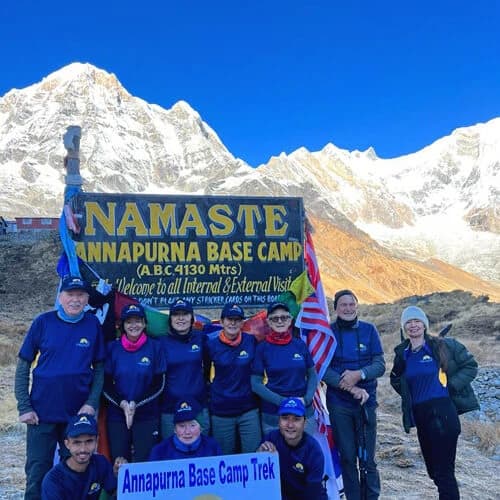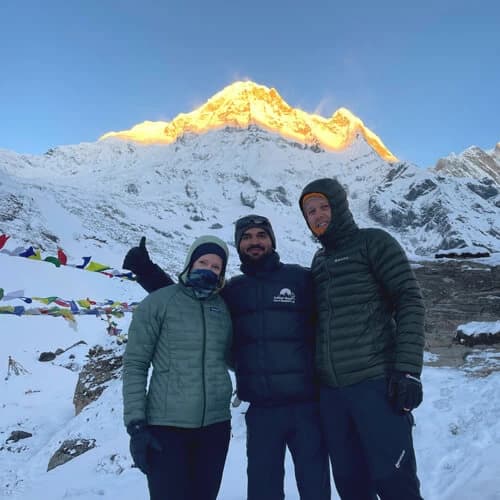"Are you someone who's curious about experiencing a high-altitude trek in the glorious Himalayas of Nepal? And you must be wondering which trekking package to choose from. Then look no further because the Annapurna Base camp trek is one of the best beginner options. This blog will help you to understand why it's suitable for you and provide tips for a safe and enjoyable trip in the Himalayas."
Can a Beginner Trek to Annapurna Base Camp?
Why is Annapurna base camp ideal for beginners?
Annapurna Base Camp trek is considered moderate and suitable for beginners with good fitness levels. One of the very evident reasons is the well-established trail, which is well-marked and supported by numerous teahouses with food and lodging. This ensures that it is easy for first-timers to go on the trek without camping gear or technical mountaineering skills.
It takes around 5 to 13 days, depending on your pace, route chosen, and itinerary. You will be walking approximately 7-8 hours per day, covering a distance of 8-10 km on varied terrain. This feat can be achieved by anyone in good health and with a moderate fitness level. The base camp sits at 4,130 meters; to reach such a height, you would have to gain significant elevation throughout the trek.
At such a high altitude, the oxygen level can be significantly lower, which can cause acute mountain sickness or altitude sickness. It is crucial for experienced and beginner trekkers alike to make gradual ascents and follow an acclimatization procedure. We also highly recommend that you begin this remarkable ABC trek with a registered travel agency for safety, logistic handling, and a seamless travel experience.
So, if you are a beginner, the Annapurna Base Camp is achievable with proper physical preparation, thoughtful packing, and research. By doing your homework, you will have realistic expectations and understand the challenges you have to tackle.
Is Annapurna Base Camp Suitable for you?
If you want to experience trekking in the high Himalayas but have no previous experience, the Annapurna Base Camp (ABC) trek could be the ideal choice. The moderately difficult journey offers a balance of challenge and reward. The ABC trek is suitable for trekkers with beginner-level experience and good fitness. In comparison to other demanding remote trek routes, the ABC trail is supported by infrastructure and well-facilitated tea houses.
Ideal candidate profile
- Participants with moderate fitness, no underlying health conditions, and a thirst for adventure and cultural immersion.
- You need to be comfortable walking 5–7 hours daily with a daypack on steep terrain and rocky landscapes.
- It is a perfect option for beginners who desire a challenging and rewarding Himalayan adventure.
- Age is not a factor; both young adventurers and old folks in good health have completed the trek.
- Mentally prepare for long days of trekking in the isolated Himalayan region.
- Understanding of gears, trekking equipment, and clothing.
How difficult is the Annapurna base camp trek?
The trek to the Annapurna Base Camp (ABC) is moderately challenging and ideal for individuals with a reasonable fitness level. It does not involve technical climbing and specialized equipment, but you will have to cover an 8 to 10-km distance on rocky and rugged terrains on a daily basis. Numerous other factors need to be considered when determining the difficulty of this trek. You should understand the elements that contribute to the challenging nature of the journey to ensure a safe and enjoyable travel experience.
- The highest point of this trek is at 4,130 meters (13,550 feet) at the base camp. The significant elevation gain might put you at risk of altitude sickness regardless of your experience and your physical fitness.
- The duration of the trek, depending on the route chosen, relates to altitude adaptation and physical exhaustion. You need to choose the right itinerary with slower ascent and rest days.
- The varied terrain and landscape, including rocky, rugged, icy trails, demands physical adaptability and agility.
- The weather at high altitudes can be unpredictable, with the chance of heavy rain, snow, and storms, which can block roads and trails.
Note: Adequate preparation, pacing, and attitude can enable most healthy people to complete the Annapurna Base Camp trek and enjoy the stunning mountain scenery and rich cultures encountered along the way.
How to Prepare Physically before the Trek
If you are a beginner planning to trek to the Annapurna Base Camp, it is crucial to be active to ensure a safe and successful trek. As you have to walk for multiple days on steep terrains and rugged landscapes, your body must be fit and healthy. Preparing your body months before the departure date ensures you can endure the physical strain and exhaustion. Here are some tips on how to get fit for the Annapurna Base Camp trek:
- Indulge in hiking, brisk walking, jogging, swimming, or cycling 3–5 times a week to build up stamina.
- Squats, lunges, planks, and step-ups to strengthen your core muscles and legs.
- Go on long walks with a weight vest or backpack to stimulate long hours of hiking.
- Incorporate stretching, yoga, or mobility work in your daily routine to increase flexibility and reduce the risk of self-induced injury.
- Train regularly and increase the intensity slowly to avoid fatigue or injury.
- Maintain a nutritious, balanced diet to rejuvenate your body.
- Note: Begin training at least 2 to 3 months before your trek for the best result.
- Mental Preparation: Building Resilience for the Journey
- Annapurna Base Camp trek is not just a physical challenge but a mental one as well. Cultivating mental resilience will make you fully appreciate the experience, especially when faced with fatigue, bad weather, or challenging climbs.
- Keeping realistic expectations will help you stay positive even during difficult moments. Recognize that there will be tough days and that progress could take longer than desired.
- Maintain mindfulness to remain relaxed and centered when the trail becomes difficult.
- Having a personal inspiration or motivation in mind will encourage you when you feel worn out.
- With a strong mindset, every challenge is part of the story, and the reward is well worth it.
Packing Essentials for a Comfortable Trek
Trekking to the Annapurna Base Camp is visually rewarding and one of the most renowned trek routes in the world. It is a life-changing experience set against the scenic backdrop of the mighty Himalayas. As you step into the world of natural splendor, the trek also unfolds certain challenges that require adequate preparation, such as a packing list. The essentials ensure not just safety but also safety, comfort, and a fulfilling trek experience. Here are some basics that must-have gear, clothing, and equipment for the ABC trek.
Head & Face Gear
- Sun Hat/Cap (Wide-brimmed for UV protection)
- Warm Beanie/Wool Hat (For cold mornings and nights)
- Neck Gaiter/Buff (Multipurpose use: wind, sun, dust, or cold protection)
- Balaclava (optional for extra warmth for high altitudes)
- Sunglasses with UV Protection (Essential at high altitudes to avoid snow blindness)
- Headlamp with Extra Batteries
Upper Body Clothing
- Moisture-wicking T-shirts (synthetic or merino wool)
- Thermal Base Layers (long sleeves for sleeping and trekking in the cold)
- Fleece Jacket or Pullover
- Lightweight Down Jacket
- Waterproof/Windproof Jacket with Hood (Gore-Tex or similar)
- Soft Shell Jacket or Vest (optional, for extra insulation)
- Undergarments (breathable & quick-drying)
Lower Body Clothing
- Thermal Leggings/Long Johns (for sleeping or cold trekking days)
- Trekking Trousers (lightweight, breathable, quick-drying)
- Convertible Hiking Pants (zip-off into shorts)
- Waterproof Hiking Pants (Gore-Tex or similar)
- Fleece/Comfortable Pants (for evenings or teahouses)
Footwear
- Waterproof Hiking Boots (well-broken-in, with ankle support)
- Camp Shoes/Sandals (for teahouses and river crossings)
- Trekking Socks (wool or synthetic; rotate and dry daily)
- Thermal Socks (for higher altitudes/sleeping)
- Gaiters (optional but useful in snow or muddy conditions)
Trekking Gear
- Backpack (40–50L for personal gear if not using a porter)
- Daypack (20–30L for essentials during the day
- Rain cover for backpack
- Sleeping Bag (0°C to -10°C comfort rating)
- Trekking Poles (Collapsible, which helps with balance and reduces joint impact)
- Water Bottles (2L total capacity)
- Water Purification (Tablets, Filter, or UV Pen)
Accessories & Personal Items
- Quick-dry towel
- Toiletries (Biodegradable soap, toothbrush/paste, floss, etc)
- Sunscreen (SPF 50+)
- Lip Balm with SPF
- Wet Wipes
- Hand Sanitizer
- Toilet Paper
- Trekking Map
- First Aid Kit (Include altitude sickness meds (Diamox if advised), painkillers, band-aids, antiseptic, personal prescriptions)
- Multi-tool / Swiss Army Knife
- Snacks/Energy Bars (Especially for long hiking days)
- Power Bank (
- Universal charging cable & adapter
Extras (Optional but helpful)
- Camera / GoPro (To capture the stunning views)
- Cash (Nepalese Rupees)
- Copy of Passport, Permits & Travel Insurance
- Ziplock Bags (for organizing and waterproofing)
Best time for the Annapurna base camp
Choosing the right time to trek to Annapurna Base Camp can significantly enhance your experience. In general, spring (March, April, May) and autumn (September, October, and November) are regarded as peak trekking seasons in Nepal. Both are characterized by clear skies, dry trails, lush landscapes, stable weather, and optimal temperatures.
Spring (March, April, May):
- The weather is mild, pleasant, and warmer, with clear skies and blooming rhododendrons adding vibrant color to the trail.
- The trails are dry and free from mud, ice, and snow in most parts of the trek routes.
- Daytime temperatures at higher altitudes range from 8°C to 15°C, while nights can drop to around -5°C.
Autumn (September, October, November):
- This season offers crisp, dry air, excellent visibility, and lush and green landscapes.
- Scenic routes with colorful trees, plants, and wildflowers surrounding both sides of the trail
- Daytime temperatures are around 10°C to 18°C at higher elevations, with cooler nights around -5°C to 0°C. Safety Measures: Staying Healthy and Secure
Optional Extensions: Enhancing Your Trek Experience
Spending a few extra days on your Annapurna Base Camp trek will give your journey depth, variety, and more adventure. Adding these additional optional extensions enhances your physical journey and presents an opportunity for reflection, cultural insight, and well-deserved relaxation, making your trek more complete and fulfilling.
- One of the most popular add-ons is Poon Hill, which allows stunning sunrise views over the Annapurna and Dhaulagiri ranges. It's a couple of days but well worth the early morning trek.
- For those who prefer culture and relaxation, spending more time in Ghandruk or Jhinu Danda can be rewarding. Ghandruk gives a peek into traditional Gurung culture, and Jhinu Danda is well-known for its natural hot springs, which are perfect for unwinding tired muscles after a hike.
- Another option is to immerse yourself in the local attractions, heritage sites, and sites of Pokhara. After the trek, this lakeside town offers tranquil boat rides, yoga retreats, massages, and adventure sports like paragliding.
- Kathmandu, the vibrant capital of Nepal, blends ancient heritage with bustling city life. Home to historic temples, colorful markets, and rich culture, it’s the perfect gateway to Himalayan adventures.
Eco-Friendly Practices: Minimizing Environmental Impact
In the ABC trek, you will have the opportunity to experience high-altitude hiking and contribute to the conservation of natural resources and cultural heritage. As more tourists visit the trail, every small step counts. By implementing environmentally friendly practices, you can leave behind a cleaner environment for future generations to enjoy and have a more fulfilling experience.
- Carry a refillable water bottle and avoid single-use plastics.
- Bring water purification tablets or filters instead of buying bottled water.
- Hike on designated trails to prevent erosion of soil and damage to plants.
- Dispose of waste correctly, leave all trash behind, and do not litter.
- Use biodegradable soaps and personal wash products to maintain safe water sources.
- Conserve energy by restricting hot showers and charging appliances wisely.
- Support local economies by staying in locally owned lodges and buying local products.
- Do not disturb the wildlife by maintaining a peaceful and quiet hike.
- Practice Leave No Trace principles to avoid affecting the environment as a whole.
- Educate yourself and others on sustainable trekking techniques.
Final Thoughts: Is ABC the Right Trek for You?
The Annapurna Base Camp (ABC) trek is a perfect initiation to Himalayan hiking, offering spectacular mountain scenery, diverse landscapes, and abundant culture. It's a great option for novices and moderately experienced trekkers seeking a rewarding yet feasible experience. The well-worn trails and comfortable teahouses make logistics easy, and the altitude is challenging but achievable with proper acclimatization.
If you enjoy nature, want to view local culture, and don't mind a couple of days of hiking, ABC could be the trek for you. You might want to consider elsewhere if you prefer less physical effort, extremely high elevation, or a more isolated experience. Ultimately, your attitude, preparation, and willingness to take the highs and lows of the journey that define your experience. With a positive mindset, Annapurna Base Camp guarantees lifelong memories and a strong sense of connection to the Himalayas.
How long does the Annapurna Base Camp trek take?
The trek takes between 7 to 12 days, depending on your pace and the itinerary chosen.
Do I need any prior trekking experience?
You do not need prior experience, but moderate physical fitness is required for a safe and enjoyable experience.
What type of accommodation is available?
Accommodation is in simple tea houses with basic rooms and food. The facilities around Pokhara are better, but they have become more basic and are closer to the base camp.
Do I need a guide or a porter?
It is not necessary, but it is recommended that a guide or porter be taken for navigation, cultural insights, and to reduce the physical load.
How difficult is the trek?
It's rated moderate because it involves 5 to 7 hours of daily hiking on mixed terrain with some steep inclines. Good fitness is required, but no technical climbing experience is needed.
Is solo trekking safe?
Solo trekking is possible but not recommended for beginners. Joining a group or hiring a guide is safer and more enjoyable.
How physically fit do I need to be?
You should be moderately physically fit and be able to walk several hours a day uphill and downhill on uneven trails.
Can I do the trek in winter?
Winter trekking is possible but more challenging because of cold temperatures, snow on the higher trails, and fewer facilities.
What wildlife can I expect to view on the trek?
You can view Himalayan birds, monkeys, and occasionally deer, and wildlife is more common in lower areas than near the base camp.
Some Most Popular Treks
- Everest Base Camp Trek - 14 Days
- 12 Days Everest Base Camp Trek
- Everest Base Camp Luxury - 14 Days
- Everest Cho La Pass - 17 Days
- Everest High Pass 16 - Days
- Annapurna Base Camp - 13 Days
- Ghorepani Poon Hill - 7 Days
- Annapurna Circuit - 17 Days
- 12 Days Annapurna Circuit Trek
- Manaslu Circuit - 14 Days
- Manaslu Trek 12 Days
- Everest Base Camp with Island Peak - 16 Days
- Everest Luxury Trek with Helicopter Return
- Langtang Valley - 10 Days



